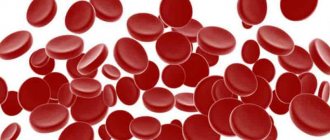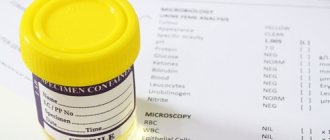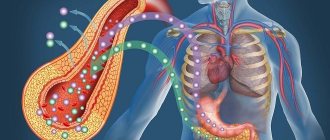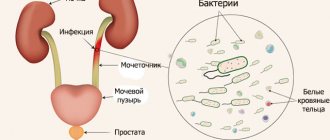There are various types of urine tests that allow this type of excrement to be used as material for making a diagnosis and/or determining the condition of the body.
Excrement is the waste products of the body, biological “exhausts”. In addition to urine and feces, excrement includes the placenta, exhaled air, sweat and other biological substances.
In this article you will learn what types of urine tests there are and some facts about each of them.
Urine examination as a diagnostic method for detecting diseases
Urine is one of the main waste products of the body. The main component of the liquid presented is water; urine contains from 92 to 99% . It also contains decay products, toxic substances and toxins, which the body got rid of naturally. The presence of such components makes it possible to analyze the state of urine and determine whether a person has diseases.
Most often, donation of the presented liquid is prescribed for suspected diseases of the kidneys and urinary system. But there are also situations when urine is donated for preventive purposes.
Why is urine acidity deviation from the norm dangerous?
When urine tests show a pH shift towards the acidic or alkaline side for a long time, there is a risk of stone formation. Stones can be of different nature, it depends on what kind of reaction of the urinary sediment is observed in the patient.
Any change in acidity in one direction or another always requires correction
The following types of stones are distinguished:
- oxalate stones (they are formed from oxalic acid salts in acid-base urine, the reaction of which is 5-6);
- urate stones (formed from uric acid, the reaction of which is below 5);
- phosphate stones (formed from phosphate-containing compounds in an alkaline environment, the pH of which exceeds 7).
As a rule, high acidity is diagnosed in patients not only in urine, but also in blood tests.
This can lead to a number of serious complications, such as:
- disruption of metabolic processes leading to a slowdown in biochemical reactions and the accumulation of toxic metabolic products and toxins in the patient’s body;
- activation and reproduction of infectious agents (representatives of pathogenic and opportunistic microflora), which can cause long-term inflammation in the kidneys or bladder;
- changes in blood viscosity, towards increased thrombus formation, worsening diseases of the cardiovascular system, etc.
General urine analysis
During the general urine analysis procedure, the chemical characteristics of the liquid are examined. Thanks to this, it is possible to perform a complete diagnosis of diseases of the kidneys, liver, bladder and identify prostate pathologies, malignant or benign tumors, pyelonephritis and other problems even in the initial stages of their course (when there are no symptoms).
While carrying a child, it is recommended to take a test once every few weeks: the kidneys are under high load, and there is a possibility of developing pathologies.
As a result of urinary fluid, metabolic products . Slag, excess vitamins and hormones, excess water, and ion particles come out with urine. Normally, the output balances the degree of other components of the body, collecting excess and processed products.
From a diagnostic point of view, the study of urinary fluid is valued due to the following features:
- Collection of data on the performance of a number of body systems.
- Correlation of urine analysis with blood.
- Delivery of urea is simple and does not require special procedures.
- To determine the presence of pathological diseases without auxiliary examinations, you need to know the result of the study.
For a complete diagnostic examination, a general urea analysis is required. It must be submitted during a medical examination. A diagnostic test will show the presence of a disease (diabetes mellitus, jaundice, inflammation of the bile ducts and gallstone disease, kidney failure, types of neoplasms, inflammation of the urinary system).
Physical properties
4.1. Quantity
When assessing the total amount of urine excreted, it is necessary to take into account the possible dietary characteristics of each patient. In an adult who follows a normal diet, daily diuresis ranges from 800 to 1500 ml.
Diuresis directly depends on the volume of fluid drunk. Typically, 60-80% of what you consume per day is eliminated from the body. The normal ratio of daytime to nighttime diuresis is 3:1 or 4:1.
A condition characterized by increased urine output (more than 2000 ml per day) is called polyuria.
A similar phenomenon is observed normally:
- 1If you have drunk a lot over the past day;
- 2In case of nervous excitement or overexertion.
Polyuria can be observed in the following pathological conditions:
- 1Kidney diseases (CKD, stage of resolution of acute renal failure);
- 2 Relief of edema, for example, against the background of diuretics;
- 3Diabetes insipidus and diabetes mellitus;
- 4Nephropathies (amyloidosis, myeloma, sarcoidosis);
- 5Taking certain medications.
The reverse condition is called oliguria. With oliguria, less than 500 ml of urine is excreted per day .
Physiologically it can occur with:
- 1Reduce fluid intake;
- 2Loss of fluid through sweat in the heat;
- 3 Significant physical activity.
It is noted in the following pathologies:
- 1Cardiac decompensation;
- 2 Poisoning;
- 3Excessive loss of water by the body (for example, during profuse diarrhea, vomiting);
- 4Burns;
- 5States of shock;
- 6 Fever of any origin;
- 7 Kidney damage of infectious, autoimmune and toxic origin.
Anuria is a condition in which urine production stops completely . Anuria is typical for:
- 1Initial stage of acute renal failure;
- 2Acute blood loss;
- 3Uncontrollable vomiting;
- 4 Stones in the urinary tract with obstruction of the lumen;
- 5 Oncological diseases accompanied by obstruction and compression of the ureters.
Nocturia is a condition in which nighttime diuresis significantly prevails over daytime . Nocturia is typical for:
- 1Diabetes insipidus and diabetes mellitus;
- 2Many kidney diseases;
- 3BPH.
4.2. Urinary frequency
In addition to the daily amount of urine, pay attention to the frequency of urination. Normally, this process is performed by a person 4-5 times during the day.
Pollakiuria is characterized by frequent trips to the toilet. Observed when:
- 1Drink a large amount of liquid;
- 2Urinary infection.
Olakiuria is the opposite condition to that described above. Characteristic for:
- 1Low intake of fluid into the body;
- 2Nervous reflex disorders.
Strangury is painful urination.
Dysuria is a urination disorder that combines symptoms such as changes in urine volume, frequency and pain. It usually accompanies inflammatory processes in the genitourinary system.
4.3. Color
Is a direct reflection of concentration. In a healthy person, deviations in color from straw yellow to amber are allowed.
The color of urine is also influenced by special substances, the basis of which are blood pigments. A dark yellow color is observed when the amount of coloring substances dissolved in it significantly exceeds the norm. Characteristic of such conditions:
- 1Swelling;
- 2Vomiting;
- 4Burns;
- 4Congestive kidney;
- 5Diarrhea.
If the content of pigment substances is minimal, the shade will be paler. Observed when:
- 1Diabetes mellitus;
- 2Diabetes insipidus.
The dark brown color is explained by an increase in the level of urobilinogen. It is a diagnostic criterion for hemolytic anemia. Urine may turn dark brown when taking sulfonamides.
Dark, practical black color can indicate several conditions:
- 1 Alkaptonuria (due to homogentisic acid);
- 2Acute hemolytic kidney;
- 3Melanosarcoma (obtains this shade due to the presence of melanin).
Urine turns red if it contains fresh blood or red pigments. This is possible with:
- 1Kidney infarction;
- 2Kidney failure;
- 3Damage and trauma to the urinary tract;
- 4Taking certain medications (for example, rifampicin, adriamycin, phenytoin).
The appearance of “meat slop” is explained by the presence of altered blood, which is characteristic of acute glomerulonephritis.
A greenish-brown tint (compared to the color of beer) appears if bilirubin and urobilinogen enter the urine. This deviation from the norm often indicates parenchymal jaundice.
If the shade is rather greenish-yellow, which may indicate the presence of bilirubin alone, and is considered a symptom of obstructive jaundice.
4.4. Transparency
Normally, urine is clear. However, in the presence of pathological components and impurities (proteins, leukocytes, erythrocytes, epithelium, bacteria, salts), it can be cloudy, cloudy and milky.
Several manipulations can be carried out in advance to narrow the range of possible substances that make up the sediment to certain salts.
When, when heated, the test tube with the test material becomes transparent again, we can conclude that it contained urates.
If the same happens upon contact with acetic acid, we can assume the presence of phosphates in the sample. If an identical effect is observed when mixed with hydrochloric acid, then there are calcium oxalates in the urine.
For more accurate data, microscopy of the sediment is performed.
4.5. Smell
The smell of urine is usually specific and not strong. An ammonia odor may appear if there is bacterial contamination of the sample. A fruity smell (of rotting apples) is considered an indicator of the presence of ketone bodies.
4.6. Relative density (SG)
This indicator is considered very important, since it is used to judge the concentration function of the kidneys and its ability to dilute.
The measurement is carried out using a specially designed device - a urometer. During the study, attention is primarily paid to the content of electrolytes and urea, and not to substances with high molecular weight (proteins, glucose, etc.).
Normally, the relative density of the morning urine portion is determined in the range from 1.012 to 1.025. During the day it can fluctuate between 1001 and 1040, therefore, if a patient is suspected of having a decrease in the concentrating ability of the kidneys, the Zimnitsky test is usually prescribed.
Hypersthenuria is an indicator higher than normal . Its cause may be:
- 1 Toxicosis of pregnant women;
- 2 Progressive edema;
- 3Nephrotic syndrome;
- 4Diabetes mellitus;
- 5Use of radiocontrast agents.
Hyposthenuria - decrease in specific gravity . Observed in the following conditions:
- 1Malignant hypertension;
- 2Chronic renal failure;
- 3Diabetes insipidus;
- 4Damage to the kidney tubules.
Isosthenuria is a condition in which the density of urine is equal to the density of blood plasma (within 1010-1011).
How to donate urine?
The rules help to avoid erroneous indicators, which can ultimately confuse the doctor and push him onto the wrong path in treatment:
- The analysis will be required in the morning on an empty stomach. It is better if the person does not go to the toilet all night.
- Before collecting, you need to wash yourself to prevent the penetration of foreign substances.
- Only the last third of urine is taken for testing.
- The container needs to be clean and dry.
- Before the analysis, do not eat foods that color the urinary fluid (beets, carrots, etc.).
- For reliable diagnosis, urea in a container must be brought no later than 1.5 hours after collection.
How to prepare for the analysis?
Human urine is sterile, but before it gets into laboratory glassware, it can be contaminated by the person themselves. Therefore, it is important to observe personal hygiene rules as much as possible so as not to affect the analysis results.
To collect biological fluid you need:
- properly clean the external genitalia, women need to use a sterile piece of cotton wool (tampon) soaked in soapy water to treat the vagina from top to bottom, men need to wash the end of the urethra with soap;
- wait for morning urine with a break of 6 hours from the previous trip to the toilet;
- when urinating, the first thing that comes out is the dead cells of the channel through which urine flows, so you need to flush the first portion of liquid into the toilet;
- in order to prevent changes in the result of the analysis, you should take sterile containers; you cannot take liquid from an intermediate container, for example, a pot, for examination;
- It is better to send the collected liquid to the laboratory immediately, try not to expose it to sunlight;
- Before collecting biological fluid, it is not recommended to eat foods that change the color of urine, for example, beets.
Also, tell your doctor about any medications or supplements you take. Medicines or dietary supplements that may affect urinalysis results:
- vitamin C;
- metronidazole;
- riboflavin;
- anthraquinone laxatives;
- methocarbamol;
- nitrofurantoin.
Types of urine tests
There are 6 types of urine tests.
Clinical (general) . The study is carried out for diseases and for prevention. Assessment takes place:
- By color.
- Transparency.
- Acidity.
- The smell.
- Densities.
- Specific gravity.
- Contents of cellular elements.
- To the squirrels.
- Glucose.
- Bacteria.
- Biochemical . Urine contains protein, glucose, amylases, creatinine, sodium, potassium, phosphorus, magnesium, myeroalbumin, urea and uric acid. All this is calculated.
- Daily biochemical . The amount of excretion of glucose, proteins, urea and other substances per day is calculated.
- Research methodology according to Nechiporenko . The number of leukocytes, erythrocytes and salts in 1 mg of morning urine is counted. It is possible to determine pathologies in the kidney and urinary tract.
- Research on Zimnitsky . The functioning of the kidney and how much urinary fluid is released per day, the correspondence of the dose of urea day and night, and its density are assessed. Indications for use: pyelonephritis, renal failure, diabetes mellitus, toxicosis.
- Amburge survey technique . The formed components of blood are determined in a portion of urea, which has accumulated over 3 hours. Can represent the condition of the urinary system.
What is OAM?
Key points:
- A urine test is not the same as a drug test or pregnancy test.
- A complete urinalysis (UCA) is often used as a preventative screening during pregnancy, before a patient undergoes surgery or as part of a routine medical or physical examination.
- The test is performed in a laboratory in a doctor's office, hospital, or specialized testing facility.
A urine test is a laboratory test. Helping your doctor detect problems with your body.
Many diseases and disorders affect how your body removes waste and toxins. The excretory system includes your lungs, kidneys, urinary tract, skin, and bladder.
Problems with any of these body parts can affect the appearance, concentration, and content of your urine.
The OAM is not a drug test or a pregnancy test, although all three tests include a urine sample.
Decoding the result
Occurs after comparing the norm of the indicator with the result obtained during the study. There are signs deciphering the urea result. The norm table is individual for both adults and children, because the tests have different assessments. For some tests, the norm is different for males and females.
For example, you should familiarize yourself with the normal indicators of a general urine test:
- Color – straw yellow. If the presented liquid acquires a darker color, this indicates the presence of dehydration, diseases of the gallbladder and liver, and may be a sign of malaria. If the urine is lighter in color, this indicates problems with the filtration abilities of the kidneys, and it may also be a sign of diabetes.
- Transparency – transparent. Natural liquid can become cloudy in the presence of kidney disease, malignant and benign formations of the urinary tract, and metabolic disorders.
- The smell is not pronounced.
- Density – varies from 1012 to 1022 g/l. If elevated levels are present, pregnancy, diabetes, and kidney disease can be assumed. Reduced levels are typical for diabetes insipidus and renal failure.
- Acidity – from 4 to 7. Elevated levels may indicate the presence of acidosis, inflammatory processes in the body, dehydration, and diabetes. Reduced rates were noted in the presence of chronic renal failure, certain types of cancer, and an increase in the level of parathyroid hormones.
- Glucose – from 0 to 0.8 mmol/l.
- Protein – from 0 to 0.033 g/l.
- Ketone bodies, bilirubin, hemoglobin – 0.
- Urobilinogen – from 5 to 10 mg/l.
- Red blood cells - in women from 0 to 3, in men - single.
- Leukocytes – in women from 0 to 6, in men – from 0 to 3.
- Epithelial cells – from 0 to 10.
- Salts, bacteria, fungi are absent.
Normal indicators
As mentioned above, the urine pH level depends on many physiological factors, such as age, weight, the patient’s diet, as well as the time the test was taken (morning or evening).
In an adult, urine acidity should normally not go beyond the range of at least 5, but not higher than 7. The average acidity level in the morning is 6.0-6.4. In the evening, the average pH is 6.4-7.0. It is this data that means that the human body is working normally.
In children, these indicators differ from those in adults. For a breastfed child, the norm is no more than 6.9, no less than 7.8. If the baby is on an artificial type of feeding, then the urine reaction should correspond to the following values 5.4-6.9.
During pregnancy, changes in pH are observed much more often, because a woman’s body undergoes serious changes not only physiologically, but also at the hormonal and physical-biochemical level. This means that pH fluctuations during gestation are quite common, but normal acidity is considered to be in the range of 5.3-6.5.
Increased level of UBC antigen in urine
The level of UBC antigen in urine increases 100-150 times in cancer cases - the cause is a malignant tumor of the bladder or upper urinary tract. A moderate and slight increase in antigen concentration is determined in cystitis, exacerbation of an infectious disease of the urinary ducts, an acute period of inflammatory diseases of other organs, and prostate adenoma. Another reason for an increased level of UBC antigen in the urine may be mechanical damage to the mucous membrane of the bladder during intravesical interventions (cystoscopy, drug administration).











